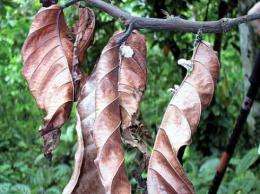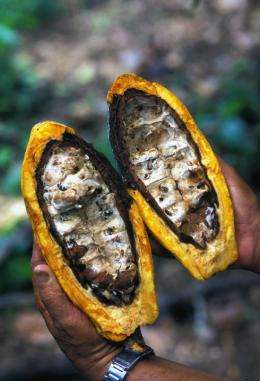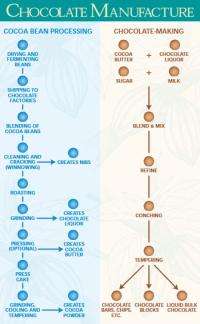The chocolate genome, unwrapped

Halloween is about monsters, ghouls and most of all, goodies. Kids might be more concerned about the quantity of treats that drop into their plastic pumpkin baskets than their quality -- but for chocolate, new research promises the opportunity to improve both.
After 10 years of planning and two years of mapping genes, two separate research groups have announced the complete sequencing of the genomes of two cacao tree varieties.
Much of the world’s chocolate comes from cocoa beans harvested from two varieties of the Theobroma cacao tree. The Forastero type is used in the bulk of the world’s chocolate production, while Criollo -- descended from plants cultivated by the Mayans -- is known for its exceptionally fine taste.
Unfortunately, all types of cacao trees are highly susceptible to disease, said David Kuhn, a molecular biologist at the U.S. Department of Agriculture in Miami, who was involved in the Forastero genome project.
“Cacao growers are constantly fighting plagues,” Kuhn said.
Brazil’s cocoa bean crop, which once dominated the world’s cacao market, has been decimated by a fungal blight known as witches’ broom. Cacao trees infected with witches’ broom grow sprays of extra stems, which divert growth energy from the cacao pods, reducing seed production.

“The fungus probably coevolved with the cacao tree in Amazonia,” said Catherine Aime, a mycologist at Louisiana State University in Baton Rouge who studies fungal genetics. “Once we domesticated the tree for agriculture and started growing whole fields of genetically similar plants, the fungus had a field day and spread uncontrollably.”
So far, witches broom and its equally destructive cousin, frosty pod, have not spread to cacao trees in Africa, where 70 percent of the world’s cacao is now grown. The old world cacao fields are not disease free, however. Other funguses, such as black pod, as well as viruses and insect plagues have also affected cocoa bean crops in Africa and Southeast Asia.
Cocoa bean shortages resulting from these plagues cost farmers an estimated $700 million in losses each year and are of particular to concern to large candy companies like Mars, Incorporated and Hershey’s Chocolate, which together produce three-quarters of all the chocolate products sold in the United States each year.
To help ensure the health of cacao trees all over the world, two years ago Mars and Hershey announced separate plans to fund the sequencing of the cacao tree genome. The group that received funds from Mars and the U.S. Department of Agriculture went after the Forastero genome while Hershey partnered with Penn State University and CIRAD, a French agency based in Paris that studies agricultural issues in developing countries, to work on the Criollo genome.
The goal isn’t to produce genetically modified candy bars, said Mark Guiltinan, a plant molecular biologist at Penn State University in University Park and a collaborator on the Criollo genome project.
Rather, by sequencing the cacao tree genome, geneticists are providing plant breeders all over the world with a powerful new tool known as marker-assisted selection that can be used to accelerate the breeding process for disease resistance and other valuable traits like drought tolerance and even flavor.

Having the cacao genome in hand could also provide a unique opportunity to study genetic interactions between pathogens and hosts, since scientists already have the genomes of witches broom and frosty pod, said Aime.
“I don’t know many other cases where genomes of both the pathogens and the host are available,” she said. “If we could find the genetic triggers underlying the infection, that could be a very useful weapon.”
Much work remains to be done, however. The next step, identifying molecular markers, is “a complicated and painstaking process,” Guiltinan said. “Sequencing is the easy part. Assembling the genome and identifying the markers is really an art form.”
Guiltinan compares the assembly process to solving ten jigsaw puzzles, one for each of the 10 chromosomes in the cacao genome, each comprised of 40 million puzzle pieces.
In the end a team of 60 scientists working at 20 different institutes in six different countries were able to assemble 76 percent of the Criollo genome and identify 96 percent of the genes. The Forastero genome project met with even greater success, with 92 percent of the genome assembled, including 35,000 genes.
While the two simultaneous projects might recall the infamous race between Celera Genomics and the publicly financed Human Genome Project to sequence the human genome, both cacao genome groups laud the other for providing the opportunity to compare the two closely related Forastero and Criollo varieties.
“To be sure, there is always a certain amount of competition in science but to call this a rivalry is too extreme,” Guiltinan said.
The Forastero genome became available online last month and the Criollo sequence will be posted on the National Center for Biotechnology Information (NCBI) website, also home to the human genome, upon the release of a paper in a yet to be announced peer-reviewed journal.
“We felt it was very important to go through the peer review process,” Guiltinan said. “On the day of publication the sequence will be freely available on National Center for Biotechnology Information and other data bases with no restrictions or legal exceptions for use.”
Both groups intend to continue perfecting their respective sequences, while moving into the next stage of translating the roughly 420 million-unit DNA sequences into hardier cacao plants around the world.
“Hopefully this project will go beyond just helping the chocolate manufacturers,” Guiltinan said. “It should help farmers create a more reliable crop that can be grown in an environmentally sustainable way.”
That’s good news for the millions of farmers who depend on Theobroma cacao, Latin for "Food of the Gods," for a living, and for chocolate-loving trick-or-treaters, who should be able to look forward to a bounty of chocolate bars on Halloween for years to come.
Provided by Inside Science News Service



















